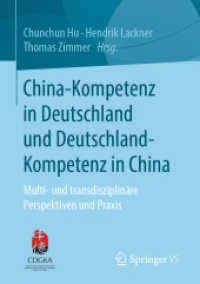- ホーム
- > 洋書
- > ドイツ書
- > Mathematics, Sciences & Technology
- > Biology
- > botanics
Full Description
This open-access book provides a comprehensive overview of current methodologies for improving resistance to leaf rust in coffee, one of the world's most important cash crops and beverages. Coffea arabica L. (Arabica) accounts for about 60% of the world's coffee production. Coffee leaf rust (CLR), caused by the fungus Hemileia vastatrix is the major disease affecting Arabica coffee resulting in losses of over $1 billion annually. The geographical distribution of CLR is expanding due to climate change. Moreover, the genetic improvement of Arabica coffee is constrained due to its very narrow genetic base. This protocol book introduces essential concepts of mutation breeding as an efficient tool to increase the genetic diversity of Arabica coffee and presents practical methods on mutation induction and screening for resistance to CLR. Current breeding approaches, challenges and opportunities for Arabica coffee improvement are briefly reviewed and a survey of common coffee diseases with emphasis on CLR is presented. Practical protocols for mutation induction and screening for resistance to CLR are described, including novel methods for single-cell mutagenesis using in vitro cell and tissue culture techniques and for genome-wide screening of induced mutations using genomics tools. Each protocol chapter has an introduction and is supported by example results. Given the impact of recent CLR epidemics on Arabica coffee production in Latin America, the book is intended to serve as a timely reference and guide for students and researchers in the agricultural sciences, plant pathologists and breeders, as well as growers and end-users interested in producing novel coffee genotypes for genetic studies, breeding, and commercial applications.
Contents
Introduction coffee breeding and challenges.- Choice of materials for mutation induction in arabica coffee.- Improved in-vitro establishment and germination of Coffea arabica seed.- Induced mutagenesis in coffee (Coffea arabica L.) using chemical agents.- Mutation induction using gamma irradiation and high frequency embryogenic callus from coffee (Coffea arabica).- Chemical mutagenesis of Coffea arabica mature seed using EMS.- Physical mutagenesis of coffee seeds.- In-vitro regeneration of Coffea arabica var. Venecia through somatic embryogenesis.- Protocol on mutation induction in Coffea arabica using in vivo grafting and cuttings.- Protocol on mutation induction in coffee using in vitro tissue cultures.- Screening for resistance to coffee leaf rust.- Protocol to send samples of coffee leaf rust to CIFC.- Coffee leaf rust (Hemileia vastatrix) inoculation and evaluation under laboratory conditions.- Development of a PCR-Based Molecular Detection.- Technique for the Early Diagnosisof Coffee Leaf.- Rust Caused by Hemileia vastatrix.- Protocols for chromosome preparations: molecular cytogenetics and studying genome organization in coffee.







